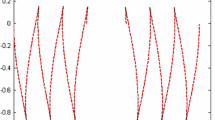Abstract
We consider Hamiltonian systems on (T*ℝ2, dq ∧ dp) defined by a Hamiltonian function H of the “classical” form H = p 2/2 + V(q). A reasonable decay assumption V(q) → 0, ‖q‖ → ∞, allows one to compare a given distribution of initial conditions at t = −∞ with their final distribution at t = +∞. To describe this Knauf introduced a topological invariant deg(E), which, for a nontrapping energy E > 0, is given by the degree of the scattering map. For rotationally symmetric potentials V(q) = W(‖q‖), scattering monodromy has been introduced independently as another topological invariant. In the present paper we demonstrate that, in the rotationally symmetric case, Knauf’s degree deg(E) and scattering monodromy are related to one another. Specifically, we show that scattering monodromy is given by the jump of the degree deg(E), which appears when the nontrapping energy E goes from low to high values.
Similar content being viewed by others
References
Bates, L. and Cushman, R., Scattering Monodromy and the A 1 Singularity, Cent. Eur. J. Math., 2007, vol. 5, no. 3, pp. 429–451.
Born, M., Zur Quantenmechanik der Stoßvorgänge, Z. Physik, 1926, vol. 37, no. 12, pp. 863–867.
Cook, J.M., Banach Algebras and Asymptotic Mechanics, in Cargèse Lectures in Theoretical Physics: Application of Mathematics to Problems in Theoretical Physics (Cargèse, 1965): Vol. 6, New York: Gordon and Breach, 1967, pp. 209–245.
Dereziński, J. and Gérard, Ch., Scattering Theory of Classical and Quantum n-Particle Systems, Berlin: Springer, 1997.
Duistermaat, J. J., On Global Action–Angle Coordinates, Comm. Pure Appl. Math., 1980, vol. 33, no. 6, pp. 687–706.
Dullin, H. and Waalkens, H., Nonuniqueness of the Phase Shift in Central Scattering due to Monodromy, Phys. Rev. Lett., 2008, vol. 101, no. 7, 070405, 4 pp.
Efstathiou, K., Giacobbe, A., Mardešić, P. and Sugny, D., Rotation Forms and Local Hamiltonian Monodromy, arXiv:1608.01579 (2016).
Efstathiou, K. and Martynchuk, N., Monodromy of Hamiltonian Systems with Complexity 1 Torus Actions, J. Geom. Phys., 2016 (in press).
Herbst, I.W., Classical Scattering with Long Range Forces, Comm. Math. Phys., 1974, vol. 35, no. 3, pp. 193–214.
Hunziker, W., The S-Matrix in Classical Mechanics, Comm. Math. Phys., 1968, vol. 8, no. 4, pp. 282–299.
Knauf, A., Qualitative Aspects of Classical Potential Scattering, Regul. Chaotic Dyn., 1999, vol. 4, no. 1, pp. 3–22.
Knauf, A., Mathematische Physik: Klassische Mechanik, Springer-Lehrbuch Masterclass, Berlin: Springer, 2011.
Knauf, A. and Krapf, M., The Non-Trapping Degree of Scattering, Nonlinearity, 2008, vol. 21, no. 9, pp. 2023–2041.
Simon, B., Wave Operators for Classical Particle Scattering, Comm. Math. Phys., 1971, vol. 23, no. 1, pp. 37–48.
Turaev, D. and Rom-Kedar, V., Elliptic islands appearing in near-ergodic flows, Nonlinearity, 1998, vol. 11, no. 3, pp. 575–600.
Author information
Authors and Affiliations
Corresponding author
Rights and permissions
About this article
Cite this article
Martynchuk, N., Waalkens, H. Knauf’s degree and monodromy in planar potential scattering. Regul. Chaot. Dyn. 21, 697–706 (2016). https://doi.org/10.1134/S1560354716060095
Received:
Accepted:
Published:
Issue Date:
DOI: https://doi.org/10.1134/S1560354716060095




